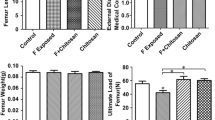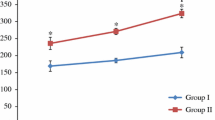Abstract
Fluorosis is a public health concern in 25 countries around the globe. The present study is about the mitigation of fluoride (F) toxicity by giving F-free water (FFW) and calcium (Ca). A study was conducted by taking 76 Wistar rats in two phases, phase I (6 months), where rats were randomly divided into four groups: normal-Ca diet (NCD) 0.5%; low-Ca diet (LCD) 0.25%; NCD + 100 ppm F and LCD + 100 ppm F in groups 1, 2, 3 and 4, respectively. F and Ca were given through water and diet respectively. Phase II is the reversal of fluorosis for 3 months, where LCD group 2 was treated with NCD. Groups 3 and 4 were divided into two subgroups each: 3X and 3Y, and 4X and 4Y, respectively. Groups 3X and 4X received FFW with NCD. Group 3Y continued as phase I and 4Y NCD and F. The biochemical expression, gene expression, biomechanical properties and DXA were studied by standard methods. The results revealed that in phase I, bone turnover was significantly increased whereas bone mineral content and biomechanical properties of group 4 were significantly decreased (p ≤ 0.05) as compared with that of all other groups. Trabecular separation and total porosity increased in groups 2 and 4. Expression of osteocalcin, osteonectin and osteopontin genes was significantly downregulated in group 4. Bone turnover in group 4X was normalised. Expressions of osteocalcin, osteonectin and osteopontin were upregulated after providing NCD and FFW. In conclusion, low calcium aggravates skeletal fluorosis which could be mitigated on supplementation of Ca and FFW.







Similar content being viewed by others
References
Shankar P, Ghosh S, Bhaskarachary K, Venkaiah K, Khandare AL (2013) Amelioration of chronic fluoride toxicity by calcium and fluoride-free water in rats. Br J Nutr 110(1):95–104
Whitford GM (1996) The metabolism and toxicity of fluoride. Monogr Oral Sci 2:1–153
Xiong X, Liu J, He W, Xia T, He P, Chen X, Yan K, Wang A (2007) Dose-effect relationship between drinking water fluoride levels and damage to liver and kidney functions in children. Environ Res 103:112–116
Kheradpisheh Z, Mirzaei M, Mahvi AH, Mokhtari M, Azizi R, Fallahzadeh H, Ehrampoush MH (2018) Impact of drinking water fluoride on human thyroid hormones: a case- control study. Sci Rep 8:2674
Khandare AL, Harikumar R, Sivakumar B (2005) Severe bone deformities in young children from vitamin D deficiency and fluorosis in Bihar- India. Calcif. Tissue Int 76:412–418
Riggs BL (1984) Treatment of osteoporosis with sodium fluoride: an appraisal. In: Peck WA (ed) Bone and mineral research, Annual 2. Elsevier, New York, pp 366–393
Marie PJ, Hott M (1986) Short-term effects of fluoride and strontium on bone formation and resorption in the mouse. Metabolism 35:547–551
Gruber HE, Baylink DJ (1991) The effects of fluoride on bone. Clin Orthop Relat Res 267:264–277
Kassem M, Mosekilde L, Eriksen EF (1994) Effect of fluoride on human bone cells in vitro: differences in responsiveness between stromal osteoblast precursors and mature osteoblasts. Euro J Endo 130:381–386
Lau KH, Baylink DJ (2003) Osteoblastic tartrate-resistant acid phosphatase: its potential role in the molecular mechanism of osteogenic action of fluoride. J Bone Miner Res 18:1897–1900
Clarke B (2008) Normal bone anatomy and physiology. Clin J Am Soc Nephrol 3:S131–S139
Thurner PJ, Chen CG, Ionova-Martin S, Sun L, Harman A, Porter A, Ager JW 3rd, Ritchie RO, Alliston T (2010) Osteopontin deficiency increases bone fragility but preserves bone mass. Bone 46:1564–1573
Martin RM, Correa PH (2010) Bone quality and osteoporosis therapy. Arq Bras Endocrinol Metab 54:186–199
Burr DB (2002) The contribution of the organic matrix to bone’s material properties. Bone 31:8–11
Young MF (2003) Bone matrix proteins: their function, regulation, and relationship to osteoporosis. Osteoporos Int 14:S35–S42
Qiu SR, Wierzbicki A, Orme CA, Cody AM, Hoyer JR, Nancollas GH, Zepeda S, De Yoreo JJ (2004) Molecular modulation of calcium oxalate crystallization by osteopontin and citrate. Proc Natl Acad Sci U S A 101:1811–1815
Tye CE, Hunter GK, Goldberg HA (2005) Identification of the type I collagen-binding domain of bone sialoprotein and characterization of the mechanism of interaction. J Biol Chem 280:13487–13492
Fantner GE, Hassenkam T, Kindt JH, Weaver JC, Birkedal H, Pechenik L, Cutroni JA, Cidade GA, Stucky GD, Morse DE, Hansma PK (2005) Sacrificial bonds and hidden length dissipate energy as mineralized fibrils separate during bone fracture. Nat Mater 4:612–616
Briancon D, Meunier PJ (1981) Treatment of osteoporosis with fluoride, calcium, and vitamin D. Orthop Clin North Am 12:629–648
Hedlund LR, Gallagher JC (1989) Increased incidence of hip fracture in osteoporotic women treated with sodium fluoride. J Bone Miner Res 4:223–225
Gutteridge DH, Price RI, Kent GN, Prince RL, Michell PA (1990) Spontaneous hip fractures in fluoride-treated patients: potential causative factors. J Bone Miner Res 5:S205–S215
Riggs BL, O’Fallon WM, Lane A, Hodgson SF, Wahner HW, Muhs J, Chao E, Melton LJ 3rd. (1994) Clinical trial of fluoride therapy in postmenopausal osteoporotic women: extended observations and additional analysis. J Bone Miner Res 9:265–275
Alarcόn-Herrera MT, Martin-Domίnguez IR, Trejo-Vázquez R, Rodriguez-Dozal S (2001) Well water fluoride, dental fluorosis and bone fractures in the Guadiana valley of Mexico. Fluoride 34:139–149
Beary DF (1969) The effects of fluoride and low calcium on the physical properties of the rat femur. Anat Rec 164:305–316
Riggins RS, Zeman F, Moon D (1974) The effects of sodium fluoride on bone breaking strength. Calcif Tissue Res 14:283–289
Mousny M, Omelon S, Wise L, Everett ET, Dumitriu M, Holmyard DP, Banse X, Devogelaer JP, Grynpas MD (2008) Fluoride effect on bone formation and mineralization are influenced by genetics. Bone 43:1067–1074
Miao Q, Xu M, Liu B, You B (2002) In vivo and in vitro study on the effect of excessive fluoride on type I collagen of rats. Wei Sheng Yen Chiu (J Hygie Res) 31:145–147
Nair M, Belak ZR, Ovsenek N (2011) Effects of fluoride on expression of bone-specific genes in developing Xenopus laevis larvae. Cell Biol 89:377–386
Yan X, Li W, Zhou B, Wang J (2007) Effect of supplemented protein and Ca on F-induced disturbance of rib COL1A1 gene expression in rabbits. Fluoride 40:140–148
Report of the expert committee of the Indian Council of Medical Research. (2010) Nutrient requirements and recommended dietary allowances for Indians; pp.122-34
Zeni S, Weisstaub S, Di Gregorio S, Ronanre De Ferrer P, De Portela ML (2003) Bone mass changes in vivo during the entire reproductive cycle in rats feeding different calcium and calcium/phosphorus ratio content. Calcif Tissue Int 73:594–600
Zeni SN, Di Gregorio S, Mautalen C (1999) Bone mass changes during pregnancy and lactation in the rat. Bone 25:681–685
Walter K, Schütt C (1971) Acid and alkaline phosphatase in serum. In: Bergmeyer HU (ed) Methods of Enzymatic Analysis, vol 2. Verlag Academic Press, Germany, pp 856–860
Trivedi R, Kumar A, Gupta V, Kumar S, Nagar GK, Romero JR, Dwivedi AK, Chattopadhyay N (2009) Effects of Egb 761 on bone mineral density, bone microstructure, and osteoblast function: Possible roles of quercetin and kaempferol. Mol Cell Endocrinol 302:86–91
Hildebrand T, Ruegsegger P (1997) Quantification of bone microarchitecture with the structure model index. Comput Methods Biomech Biomed Engin 1:15–23
Hara K, Kobayashi M, Akiyama Y (2002) Vitamin K2 (menatetrenone) inhibits bone loss induced by prednisolone partly through enhancement of bone formation in rats. Bone 31:575–581
Bhargavan B, Gautam AK, Singh D, Kumar A, Chaurasia S, Tyagi AM, Yadav DK, Mishra JS, Singh AB, Sanyal S, Goel A, Maurya R, Chattopadhyay N (2009) Methoxylated isoflavones, cajanin and isoformononetin, have non-estrogenic bone forming effect via differential mitogen activated protein kinase (MAPK) signaling. J Cell Biochem 108:388–399
Kuroda S, Virdi AS, Dai Y, Shott S, Sumner DR (2005) Patterns and localization of gene expression during intramembraneous bone regeneration in the rat femoral marrow ablation model. Calcif Tissue Int 77:212–225
Riggs BL, Hodgson SF, O’Fallon WM, Chao EY, Wahner HW, Muhs JM, Cedel SL, Melton LJ 3rd (1990) Effect of fluoride treatment on the fracture rate in postmenopausal women with osteoporosis. N Engl J Med 322:802–809
Tiwari S, Gupta SK, Kumar K, Trivedi R, Godbole MM (2004) Simultaneous exposure of excess fluoride and calcium deficiency alters VDR, CaR, and Calbindin D 9 k mRNA levels in rat duodenal mucosa. Calcif Tissue Int 75:313–320
Khandare AL, Rao GS, Balakrishna N (2007) Dual energy X-ray absorptiometry (DXA) study of endemic skeletal fluorosis in a village of Nalgonda District. Andhra Pradesh, India, Fluoride 40:172–179
Gutterridge DH, Stewart GO, Prince RL, Price RI, Retallack RW, Dhaliwal SS, Stuckey BGA, Drury P, Jones CE, Faulkner DL, Kent GN, Bhagat CI, Nicholson GC, Jamrozik K (2002) A randomized trial of sodium fluoride (60 mg) ± estrogen in postmenopausal osteoporotic vertebral fractures: increased vertebral fractures and peripheral bone loss with sodium fluoride; concurrent estrogen prevents peripheral loss, but not vertebral fractures. Osteoporos Int 13:158–170
Kragstrup J, Shijie Z, Mosekilde L, Melsen F (1989) Effect of sodium fluoride, vitamin D and calcium on cortical bone remodelling in osteoporotic patients. Calcif Tissue Int 45:337–341
Gutteridge DH, Boivin G, Meunier PJ (1990) Fluoride in postmenopausal osteoporosis: selective increase in external cortical porosity correlates with cancellous volume increase without change in cortical bone volume. In: Christiansen C, Overgaard K (eds) Osteoporosis 1990. Osteopress, Copenhagen, pp 718–720
Li G, Ren L (1997) Effects of excess fluoride on bone turnover under conditions of diet with different calcium contents. Zhonghua Bing Li Xue Za Zhi 26:277–280
Ringe JD, Dorst A, Kipshoven C, Rovati LC, Setnikar I (1998) Avoidance of vertebral fractures in men with idiopathic osteoporosis by a three year therapy with calcium and low-dose intermittent monofluorophosphate. Osteoporos Int 8:47–52
Reginster JY, Meurmans L, Zegels B, Rovati LC, Minne HW, Giacovelli G, Taquet AN, Setnikar I, Collette J, Gosset C (1998) The effect of sodium monofluorophosphate plus calcium on vertebral fracture rate in postmenopausal women with moderate osteoporosis. A randomized, controlled trial. Ann Intern Med 129:1–8
Meunier PJ, Sebert JL, Reginster JY, Briancon D, Appelboom T, Netter P, Loeb G, Rouillon A, Barry S, Evreux JC, Avouac B, Marchandise X (1998) Fluoride salts are no better at preventing new vertebral fractures than calcium-vitamin D in postmenopausal osteoporosis: the FAVO Study. Osteopo ros Int 8:4–12
Einhorn TA, Wakley GK, Linkhart S, Rush EB, Maloney S, Faierman E, Baylink DJ (1992) Incorporation of sodium fluoride into cortical bone does not impair the mechanical properties of the appendicular skeleton in rats. Calcif Tissue Int 51:127–131
Turner CH, Akhter MP, Heaney RP (1992) The effects of fluoridated water on bone strength. J Orthop Res 10:581–587
Turner CH, Garetto LP, Dunipace AJ, Zhang W, Wilson ME, Grynpas MD, Chachra D, McClintock R, Peacock M, Stookey GK (1997) Fluoride treatment increased serum IGF-1, bone turnover, and bone mass, but not bone strength, in rabbits. Calcif Tissue Int 61:77–83
Xu H, Liu QY, Zhang JM, Zhang H, Li GS (2010) Elevation of PTH and PTHrp induced by excessive fluoride in rats on a calcium-deficient diet. Biol Trace Elem Res 137:79–87
Khandare AL, Gourineni SR, Validandi V (2017) Dental fluorosis, nutritional status, kidney damage, and thyroid function along with bone metabolic indicators in school-going children living in fluoride-affected hilly areas of Doda district, Jammu and Kashmir, India. Environ Monit Assess 189(11):579–587
Funding
This study was financially supported by the Indian Council of Medical Research.
Author information
Authors and Affiliations
Corresponding author
Ethics declarations
All experimental protocols and procedures were approved by the Institutional Animal Ethical Committee (No. P9F/IAEC/2007/ALK/WNIN-76M, dated 5-12-2007) NIN, Hyderabad, India.
Additional information
Publisher’s Note
Springer Nature remains neutral with regard to jurisdictional claims in published maps and institutional affiliations.
Rights and permissions
About this article
Cite this article
Shankar, P., Khandare, A.L., Validandi, V. et al. Supplementation of Calcium and Fluoride-Free Water Mitigates Skeletal Fluorosis in Fluoride-Intoxicated Rats. Biol Trace Elem Res 199, 2225–2237 (2021). https://doi.org/10.1007/s12011-020-02326-1
Received:
Accepted:
Published:
Issue Date:
DOI: https://doi.org/10.1007/s12011-020-02326-1




